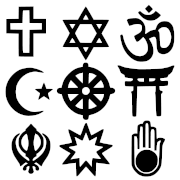
In Mahayana Buddhism the Buddha is said to have three bodies, which in Sanskrit are called Trikaya (tri-three, and kaya-body). These consist of:
1. Dharmakaya: Buddha body of universal principle (dharmadhatu), which is beyond comprehension, yet is the Emptiness, or Buddha-Mind (depending on which of two major schools of thought one adheres to) within all things, yet transcendent beyond all things, as ultimate reality;
2. Sambhogakaya: Buddha body of enjoyment, or bliss. This is the exalted place of assembled buddhas who receive the teaching of the Buddha. It is also a place of deity;
3. Nirmanakaya: The Buddha body of appearances, or transformation body. This is the body the historical Buddha walked in on earth.
Often the Trikaya is called a "Buddhist Trinity", but is this term accurate? Is the Christian doctrine of the Holy Trinity, (One God in Essence, subsisting in Three Persons: the Father, the Son, and the Holy Spirit) comparable to this Buddhist teaching?
First of all, the Trikaya are emanations of the One Buddha-Nature, or Buddha-mind which is One. This is similar to the Judeo-Christian God in His Oneness, which is a Oneness of Essence, but are the Persons of the Trinity emanations? By and large this is not an acceptable theology within Christianity. However, this disbelief is based on the temporeality of the idea of emanationism.
Yet I believe that the Persons of the Trinity are successive emanations from each other, much as the Trikaya are. But with a couple of important differences:
1) The emantaions of the Godhead are eternal, which is to say that God is forever revealing Himself through the speaking forth of the Logos, the Father is always birthing forth the Son, as Scripture says, Thou art my Son; this day have I begotten thee.- Ps 2.7. So also the Holy Spirit is sent forth eternally, and thus He continuously renews the face of the earth (Ps 104.30 );
2) And, the Buddhists believe that the emanated buddhas, especially of the Sambhogakaya and Nirmankaya, have no real permanence, no existence, but are appearance only. They are considered, as well as everything else, as "empty dharmas". This is a docetic view of deity, and the cosmos. Docetism being the Gnostic Christology that while the historical Jesus walked the earth he wasn't really here physically (that corporealty is so evil, how could He have incarnated), but was here only in appearance. Thus the view is called epiphanic, and the philosophy can be applied to various cosmological doctrines. Thus the obvious difference would be that the Father, Son, and Holy Spirit do exist as such. With the Trikaya, only the Dharmakaya as the Buddha-principle is the ultimate reality, Emptiness, or Mind.
I can see a correlation, not so much between the Trikaya and the Persons of the Trinity as Persons, but as to the sphere or domain of each Person of the Trinity:
1.The Dharmakaya correlates to the Father in that He is the First emanation, or the First Emanator, as both statements are simultaneously true, as God is Self-revealed. He is closest to the Essence, the Godhead being the Father. But without the Son we would not have known the Father (Mt 11.27), He would have forever remained Agnostos Theos (Acts 17.23), the Unknown God, which He is in Essence, as is the Dharmakaya;
2. The Sambhogakaya is correlative with the Son, in that all deity is revealed in Him (Col 1.15; 2.9; Heb 1.3). Anything that we know of God, of the Father is revealed in Him, as Jesus said, he that hath seen me hath seen the Father- Jn 14.9b. And so it is with the assembly of buddhas in the heavenly realms of Sambhogakaya, they teach through their deity-like status, and enlightenment the reality of the innermost essence that is called Buddha-nature, or Buddha-mind. Through their dharma (teaching), they show the inmost essential nature of emptiness, they do so through their own enlightenment. This is also taught of the bodhisattvas, who are buddhas-to-be, but hold off on their own enlightenment in order to lead others to attainment;
3. The Nirmanakaya is comparable to the Holy Spirit in that, as the Nirmanakaya represents the empty dharma of phenomenal existences, so too the Holy Spirit relates in a special way to the cosmos in that He conveys the glories and revelations of deity which are the entities which come into manifest reality. The difference here though is that while the Buddhist cosmos is mere appearance, the cosmos of Christianiy is the very incarnation of deity through the Being of God (Acts 17.28). True, in and of ourselves we have no existence, and to think that we do independent of God is our own "maya-delusion"(Ga 6.3), yet in stead of negating our existence through the essential emptiness (which thing is also true in relation to the divine Essence -we are less than nothing- Ps 62.9), we are affirmed as existents through the very incarnation of deity who is being. This existence then is ever, and always renewed by this Breath.
Thus the Trikaya-Trinity comparison is one of function rather than one of a diversity of personalities within a Godhead, especially as the Trikaya are not perceived as a threeness of persons subsisting as one. And a major difference, too, is of existence, not only cosmologically, but also theologically.
I can see a correlation, not so much between the Trikaya and the Persons of the Trinity as Persons, but as to the sphere or domain of each Person of the Trinity:
1.The Dharmakaya correlates to the Father in that He is the First emanation, or the First Emanator, as both statements are simultaneously true, as God is Self-revealed. He is closest to the Essence, the Godhead being the Father. But without the Son we would not have known the Father (Mt 11.27), He would have forever remained Agnostos Theos (Acts 17.23), the Unknown God, which He is in Essence, as is the Dharmakaya;
2. The Sambhogakaya is correlative with the Son, in that all deity is revealed in Him (Col 1.15; 2.9; Heb 1.3). Anything that we know of God, of the Father is revealed in Him, as Jesus said, he that hath seen me hath seen the Father- Jn 14.9b. And so it is with the assembly of buddhas in the heavenly realms of Sambhogakaya, they teach through their deity-like status, and enlightenment the reality of the innermost essence that is called Buddha-nature, or Buddha-mind. Through their dharma (teaching), they show the inmost essential nature of emptiness, they do so through their own enlightenment. This is also taught of the bodhisattvas, who are buddhas-to-be, but hold off on their own enlightenment in order to lead others to attainment;
3. The Nirmanakaya is comparable to the Holy Spirit in that, as the Nirmanakaya represents the empty dharma of phenomenal existences, so too the Holy Spirit relates in a special way to the cosmos in that He conveys the glories and revelations of deity which are the entities which come into manifest reality. The difference here though is that while the Buddhist cosmos is mere appearance, the cosmos of Christianiy is the very incarnation of deity through the Being of God (Acts 17.28). True, in and of ourselves we have no existence, and to think that we do independent of God is our own "maya-delusion"(Ga 6.3), yet in stead of negating our existence through the essential emptiness (which thing is also true in relation to the divine Essence -we are less than nothing- Ps 62.9), we are affirmed as existents through the very incarnation of deity who is being. This existence then is ever, and always renewed by this Breath.
Thus the Trikaya-Trinity comparison is one of function rather than one of a diversity of personalities within a Godhead, especially as the Trikaya are not perceived as a threeness of persons subsisting as one. And a major difference, too, is of existence, not only cosmologically, but also theologically.


No comments:
Post a Comment